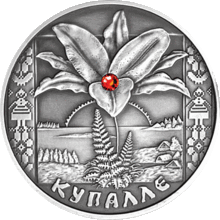Fern flower
This article needs additional citations for verification. (February 2010) |
The fern flower is a
Tradition
According to the myth, this flower blooms for a very short time on the eve of the
Estonian and Baltic
In the Polish, Estonian, Lithuanian and
Referring to this tradition, Papardes zieds ("fern flower" in Latvian) is the name of an
Swedish
Similar beliefs are attested in
East Slavic

In
According to folklore, the flower is
Polish
In many parts of Poland adder’s tongue Ophioglossum vulgatum was believed to be fern flower. It is a fern that does not look like a fern. It lacks the characteristic divided fine leaves. The leaf is simple and is accompanied by a stalk with spores. Altogether it looks like a green calla-type flower or a plantain. It is amazing that people in the Polish countryside, hundreds of years ago, figured out that it is a kind of fern. Central Europe is rife with stories of a flowering fern blooming only on Midsummer night or at Christmas. And in Poland, the flowering fern usually meant adder’s tongue. A lot of magic powers were attributed to this plant. The plant is very small and easy to overlook in grass swards. It was believed that adder’s tongue opened all locks. It also brought immense luck in love. The following love charm was uttered while collecting the plant:[4]
Nasięźrzale, nasięźrzale,
Rwę cię śmiale,
Pięcią palcy, szóstą, dłonią,
Niech się chłopcy za mną gonią;
Po stodole, po oborze,
Dopomagaj, Panie Boże.
Adder’s tongue, adder’s tongue,
I bravely collect you,
With five fingers, with the sixth hand;
Let boys chase me,
Around the barn, around the shed,
Let God help.
Blooming ferns

See also
Notes
- ^ "Blommor äro en raritet om de tagas de nätter de tros blomma. De blommor som äro naturliga tror ingen vara tibastblommor." Ericsson, Folklivet i Åkers och Rekarne härader, p. 251.
References
- ^ "Paparčio žiedo legenda - būdas kiekvienam pasijusti herojumi". DELFI.lt. Retrieved 23 June 2011.
- ISBN 978-91-85540-57-0. Archived from the original(PDF) on 2017-11-07. Retrieved 2017-11-01.
- ^ Midsummer celebration (Celebration of Ivan Kupala Day)
- ISBN 979-8639137013.)
{{cite book}}: CS1 maint: date and year (link - ^ "Saint John's Wreaths and Fern Flower" (in Polish)
